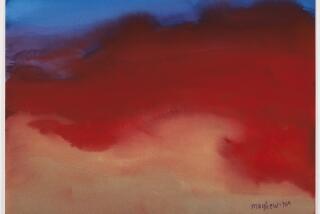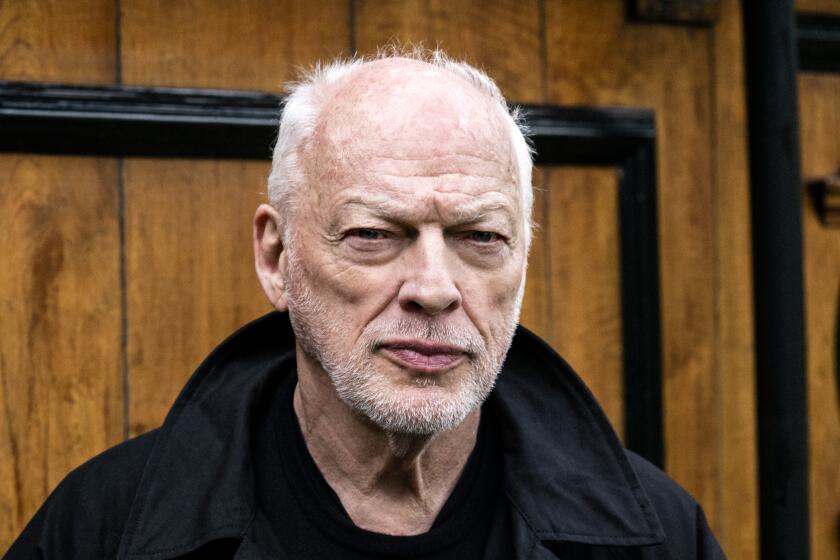JAZZ REVIEW : He Has Fusion Down to an Art : Rob Mullins and band blend rock, jazz, classical and world-beat styles to intriguing effect in a satisfying concert Sunday.
- Share via
COSTA MESA — Too often a musician’s work is dubbed “fusion” strictly because of its instrumentation. Plug in a few instruments, turn up the volume and voila , you’ve got a fusion band.
But real fusion melds styles as well as instruments. That’s what keyboardist-composer Rob Mullins does. Not only does Mullins blend acoustic and electric instruments in his band, he also mixes styles, fusing jazz and rock beats with world-beat and even classical elements. The result, as heard Sunday at the Fine Arts Recital Hall on the Orange Coast College campus, is an intriguing, often spicy stew of rhythms and moods, one that is satisfying even in large portions, as this nearly two-hour concert attested.
Of course, any stew is only as good as its ingredients, and these were all top-notch. Start with Mullins’ expansive compositions--tunes that rely less on riffs than on shifting tempos and moods. Add first-rate musicians who can spice up the already heady mix--in this case bassist Alphonso Johnson, drummer Ndugu Chancler and saxophonist Wilton Felder, not to mention Mullins himself. Then watch them turn on the heat.
And turn on the heat they did, right from the opening number, “Quick, Call the Note Police.” Mullins established the tempo with a series of throaty tones he pulled from one of two synthesizers set atop the grand piano, before Chancler erupted with a driving attack anchored by Johnson’s hard-knuckled bass line. After a turbulent bridge passage, Felder jumped into a strong tenor improvisation that featured his octave leaps into the upper register.
Suddenly, the tune slowed to half speed as Johnson added a melodic cleanly cut bass lead decorated by Mullins’ chordal fills. But the furious pace resumed after a series of ringing double tones from Johnson, and the foursome steamed ahead into a dramatic climax.
So it went throughout the show. Ballads contrasted with funk tunes; other numbers relied (but not exclusively) on the traditional jazz walk. Throughout, Mullins applied a rainbow’s worth of color with his synthesizer, simultaneously doing his best improvising on the acoustic piano.
The pianist, who often accompanied his right-hand solos with synthesizer chords struck by his left hand, is a deft tale spinner, constructing improvs for strong dramatic and emotional effects. Sticking mainly to the grand, he put a sweet swing-and-sway approach to his Brazilian-inspired “Samba.” His acoustic work on “First Love” was thick and meaty with the kind of embellishments that recalled Herbie Hancock’s better work.
Felder, best known for his work with the Crusaders, continues to possess one of the most satisfying of tenor tones; his mellow, relaxed approach was especially satisfying during uptempo numbers. He showed exceptional cool on Mullins’ “Very Blue,” a piece that featured the band’s tight stop-breaks and Johnson’s smart walk.
Felder’s tone was especially airy on the lament, and the audible buzz of his reed--this was one of the best sounding concerts in recent memory--added a chilling touch. Felder also showed his alto skills on the funk-shuffle “Boys Will Be Boys,” playing the beat-minded tune with the kind of wit that witless crossover saxophonists such as David Sanborn should get hip to.
The evening’s most impressive performer, though, was Chancler. It’s easy to see why he’s billed as a percussionist rather than a drummer, even though he employed nothing more than a modest drum kit. Like Max Roach, Chancler takes a harmonic approach, and he produced a nearly unbelievable variety of tones while making use of his rims, stands and cymbal edges. During one quiet passage, he even played cymbals with his bare hand for a soft, warm effect.
Mullins made the mistake of getting into a series of percussive exchanges with his drummer, using drum sounds produced by his keyboards. He was badly outgunned, but persisted long after he should have conceded to superior rhythmic forces.
The evening’s most moving moments came during Mullins’ “Daybreak,” a pensive number he dedicated to singer and jazz impresario Diane Varga, who died unexpectedly last week. Working alone, the keyboardist developed an orchestral sound filled with classical figures and celestial effects that climaxed with touching acoustic lines sprinkled with twinkling synthesizer accents. If there’s an elevator to heaven, this is the background music to be heard on the trip.
More to Read
The biggest entertainment stories
Get our big stories about Hollywood, film, television, music, arts, culture and more right in your inbox as soon as they publish.
You may occasionally receive promotional content from the Los Angeles Times.








